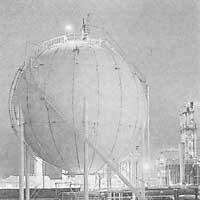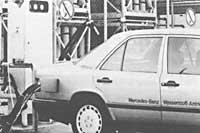Hydrogen as fuel in Europe
1987/10/01 Etxeberria, E. Iturria: Elhuyar aldizkaria

The European Economic Association seeks something that reduces and represents its dependence on oil. The solution can be hydrogen. Gas meets all conditions. It can supply vehicles and power plants. Hydrogen can be transported well: in a gaseous state in high-pressure pipelines and bottles; in a liquid state in tanker trucks; and in a solid state in combination with other chemical elements such as metal hydrides or cyclohexane. There is still a reason why hydrogen has not been used, that is, it is too expensive.
Electrolysis of water
The key is the performance of water electrolysis. It is a process that can produce hydrogen in large quantities. Electrolysis involves passing the electric current from one electrode to another through the water and dissociating the liquid into two parts of the hydrogen and a part of the oxygen. The amount of gases released is directly proportional to the current passing between the electrodes.
Current electrolysis cannot produce large amounts of hydrogen at low cost. Therefore, a few years ago the European Economic Association began to investigate on more effective technology. France and Belgium are, it seems, the countries suitable for the implementation of the new technology, since they produce a large amount of electricity from nuclear power plants and renewable energy sources. They are the closest European states to the hydrogen economy.
In view of the research carried out, the Association could take into account additional support for advanced electrolysis. But before starting to do anything, the Association expects some interest from the industry.

The largest hydrogen market, i.e. two-thirds of normal consumption, is the production of ammonia for fertilizers. Other important departments are oil refining and the chemical industry. This gas is necessary to produce methanol in this last area. Other small fields of hydrogen are: food, electronics, engineering, production of synthetic fibers, processing of chemical and mineral elements, etc.
Paul Glynn, one of EVE's hydrogen experts, tells us he wrote a simple computer model called HYTECH to assess hydrogen production costs. This model compares electrolysis, natural gas and carbon gasification to meet hydrogen demand from today through 2000.
According to hytech, in Belgium and based on a limited date of electricity prices, until 2000 advanced electrolysis in the production of ammonia will not be useful. The start-up of the electrolyzer only at night and on weekends (when Belgian electricity prices are the lowest) would not be profitable or practical. But the way in which Belgium sells electricity would be even more expensive the continuous commissioning of the process.
Oil refineries are the second consumer of hydrogen, which spends 20% of world production. At this time, most of the gas needed by refineries is obtained as a side product of oil. However, within 15 years, the removal of sulfur oil pollutants and rapid fragmentation of heavy oil products will require additional hydrogen sources. The problem that French oil refineries currently have is the lack of underground gas storage space. This means that during the summer months they will have to almazonate enough electrolyzed liquid hydrogen to stay in winter.
However, occasionally oil refineries will have to pay a force of 10 megawatts to maintain the small electrolysists they need and are in continuous operation. 8 small facilities of this type would be sufficient to cover 8% of the hydrogen market in the oil industry.
In Belgium, oil refineries encounter the same problem as ammonia production.

Specialized consumers need 10% of global hydrogen production. It will increase by 5% annually, faster than any other hydrogen market.
Advanced electrolysis rises
If the computer model predictions are correct, advanced electrolysis by 2000 could supply 6 percent of the total hydrogen used in the European Economic Community or 30 petajoules (one petajoule is 10 15 Joule). The construction of the necessary 25 electrolytes would cost about 525 million pounds sterling.
The Canadian Institute of Hydrogen Systems believes that EVD can also export advanced electrolysectors. They are able to produce cheap and abundant hydroelectricity in many parts of the world to produce the necessary hydrogen. Others already depend on nuclear force (Sweden, Finland, Switzerland, etc.) The Institute considers that nations outside the EEC can produce 90 petajoules of hydrogen annually by advanced electrolysis. Considering that Europe can supply one third of the necessary electrolysis, EVD is expected to export one for each time it is sold within the convergence.
The application of advanced electrolysis will not likely generate new jobs in the EVD, but the export of equipment in the 1990s would mean the loss of 26,000 jobs. With these exports and reducing oil imports in the community, hydrogen could contribute to the EVD balance of payments with £110 million a year.
These benefits, and perhaps more, could be had by the year 2000. But first, European CEOs should be interested in advanced electrolysis that demonstrates the usefulness of high-level technology.

Gai honi buruzko eduki gehiago
Elhuyarrek garatutako teknologia




